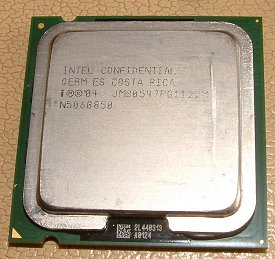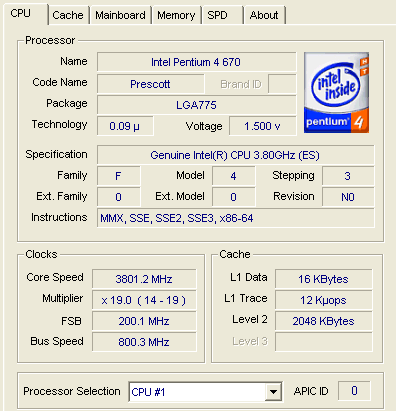Pentium 4 670
Pentium 4 670We took a look at the new 600-series of Pentium 4 CPUs in our review three or so months back. For those of you too lazy to click a link, and I'm usually in that boat, a quick summary of the 600-series' attributes.
More cache
The 500-series of Prescott Pentium 4s carried 1MB of L2 cache. L2 cache is an area of on-chip memory that stores data for the thread currently being executed. Running at full core speed, accesses to L2 cache are orders of magnitude faster than running back to system memory. Generally-speaking, the larger the cache, the better. Gaming, in particular, sees a boost with larger on-chip caches. 600-series CPUs, and the Pentium 4 670 is now the fastest, double the L2 cache levels to 2MB. Housing an extra 1MB cache pushes up the 600-series transistor count to around 169 million, which is ~35m more than any 500-series'. The cost of the extra cache is inevitably passed on to the consumer. As a reference point, a Pentium 4 560J weighs in at around £270. The equivalently clocked 660 hits the wallet harder, at around £380. So it's more cash for more cache! (no more poor jokes, promise)
Power-saving features
All 600-series CPUs support what Intel terms C1E Halt State. Put simply, with an appropriate OS and motherboard BIOS to activate it, C1E drops the CPU's multiplier and voltage to lower levels when a HLT (halt) command is issued. It makes implicit sense; why run at full speed and voltage when the system is just ticking over? Once an application demands CPU power, the voltage and multiplier are raised back to performance levels. There's also Enhanced SpeedStep (EIST), which is similar to C1E, and Thermal Monitoring 2, which intelligently reduces clock speed and voltage if the CPU begins to overheat.
64-bit and NX bit
The 600-series also benefit from Intel's AMD-like 64-bit extensions that will allow the CPUs to run 64-bit OS and code. Windows XP 64-bit has already shipped and drivers are slowly but surely getter better. NX Bit, when implemented, stops code from being run in certain areas. It looks great on paper, but the majority of naughty viruses use more creative ways of execution.
With that in mind, the Pentium 4 670 replaces the 660 as the fastest 600-series CPU. The difference is in clock speed, with the 670 now ticking along at 3.8GHz. That now matches the fastest 500-series' clock speed.


There's nothing remarkable about the review sample. Expect retail models to be packaged up with an Intel-branded copper-bottomed cooler.

It's still stuck on a 200MHz FSB. It's strange that Intel chipsets have supported a 266MHz FSB for some time now and DDR2 memory is hitting the 400MHz mark with ease, yet all Pentium 4 processors barring Extreme Editions run at 200MHz. A 3.73GHz (14x266MHz FSB) model would have been appreciated. The Pentium 4 670 model has a TDP of around 115W. Cooled by an Intel reference copper-bottomed design, the processor hit 66c under Windows load. It's one toasty CPU.









